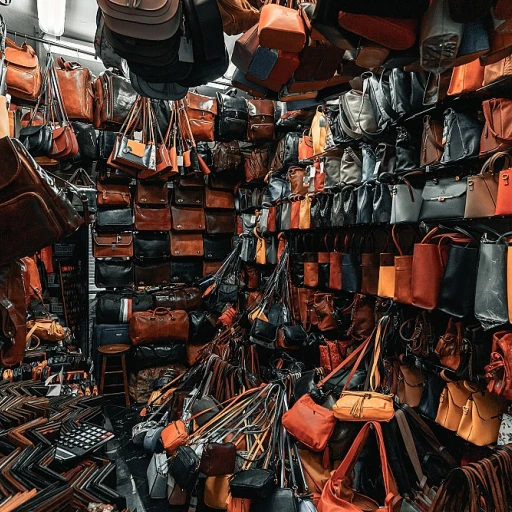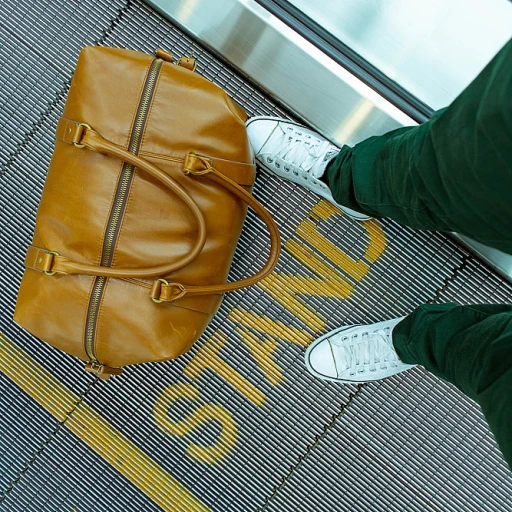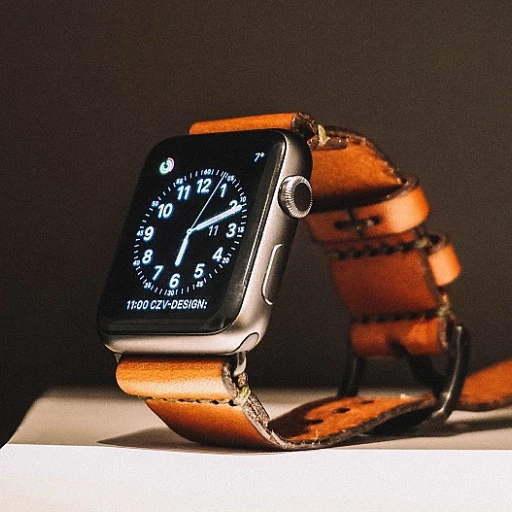Le Point de Virage: Why Upcycling is Essential for Luxury Leather Brands
The Imperative Shift Towards Sustainable Luxury
In recent years, the luxury leather goods market has seen a pivotal shift towards sustainability, with upcycling becoming an essential practice for brands striving for eco-luxe status. The need for environmentally conscious manufacturing in the leather industry is underlined by startling statistics: the global leather goods market, valued at approximately $394.12 billion in 2020, is expected to generate considerable waste. With such a market size, even a small percentage of waste represents a significant environmental impact.
This conscious evolution is not just a trend but a business imperative, as consumers are increasingly leaning towards brands that demonstrate environmental stewardship. It's clear that luxury leather brands are not just selling products, but are also communicating values; thus, integrating upcycling practices presents a unique selling proposition that aligns with modern consumer expectations.
Navigating the Upcycling Transformation
As the industry progresses, upcycling initiatives within the world of high-end leather are not just about waste reduction—they encompass a holistic brand philosophy that defines the very essence of what it means to be a sustainable luxury brand. Innovative strategies are being implemented, transforming leather remnants and outdated goods into new, covetable pieces with an aura of exclusivity and responsibility. In fact, some brands have seen an increase in consumer engagement simply by showcasing their commitment to upcycling initiatives, which often resonates with the values of their target demographic.
To explore this strategic transformation further, we look into various upcycling approaches pioneering new standards in the sector, reflective of a broader sustainability movement that luxury leather brands cannot afford to ignore. Moreover, engaging with consumers on topics such as sourcing ethics and product lifespan significantly enhances brand reputation and customer loyalty, paving the way for a more sustainable future in the luxury leather goods landscape.
A Journey Reimagined: Upcycled Leather as a New Luxury Statement
By invigorating pre-owned or excess materials, luxury leather brands craft compelling narratives around their products, portraying them as treasures reborn with a history and character that new materials simply cannot match. This is not just recycling—it's a re-imagination of luxury, as each upcycled piece tells a unique story of transformation and longevity, embodying the principles of sustainable luxury. It's a profound statement that speaks to the ethos of influential luxury consumers who are actively seeking out brands that align with their personal values and the larger global sustainability goals.
Discoveries made within the realm of upcycling luxury leather goods are often shared among connoisseurs, reinforcing the idea that upcycling isn't a mere trend, but rather a cultural shift in the perception of luxury. The transformation of leather scraps into high-end marvels is not just a creative endeavor but a necessity for the continued relevance of luxury brands in an eco-aware market. For an insight into the transformative journey of leather waste into luxurious creations, you may want to explore how luxury leather waste is turned into high-end marvels, signaling the rise of a new standard in luxury leather goods.
Stratégies Vertes: Upcycling Approaches Gaining Traction in High-End Leather
Introducing Green Innovations in High-End Leather Goods
In the realm of luxury leather goods, upcycling is more than a trend—it's a mission essential to maintaining the allure and exclusivity of high-end products while serving an eco-conscious consumer base. With sustainability as a priority, luxury leather brands are integrating upcycling, reducing waste and promoting a circular economy. Recent statistics indicate that sustainable practices can increase consumer interest by upto 45% in the luxury market. Integrating environmentally friendly techniques can thus be seen as a strategic move to align with consumer values and market demand.
The Art of Upcycled Elegance in Leather Luxuries
Renowned luxury brands are pioneering the use of upcycled materials to craft their iconic leather goods. Initiatives such as using remnants from previous collections or sourcing from responsible suppliers are becoming part of their green strategies. Upcycling in luxury leather is not just about recycling but elevating the material to a new level of sophistication. A study has shown that 60% of luxury consumers prefer brands that demonstrate environmental responsibility, making innovative upcycling practices a unique selling proposition for discerning customers.
Sustainable Sourcing: A New Chapter in Leather Craftsmanship
Breaking through the traditional supply chain, luxury brands are now actively engaging with artisans and suppliers who offer upcycled leather, creating a narrative of sustainability around each piece. This sourcing strategy not only boosts the brand's image but also contributes to a decrease in the industry's carbon footprint—fashion production contributes to 10% of humanity’s carbon emissions. By adopting sustainable sourcing, luxury leather goods companies can position themselves as frontrunners in the eco-luxe movement while enhancing their product's value proposition.
Fostering Creativity and Innovation in Upcycled Leather Designs
- Innovative Techniques: Leather brands are pushing boundaries with new distressing and re-texturizing techniques to give a unique character to upcycled materials.
- Collaborative Efforts: High-end brands are partnering with design schools and innovators to create cutting-edge, upcycled leather goods.
- Eco-Luxe Aesthetics: Upcycled pieces often feature unique patinas and histories, adding to the narrative and desirability of the luxury item.
These innovations are not just about meeting the 'sustainable luxury' tagline, they are about reinventing the industry standards—proving that upcycling can indeed become synonymous with high fashion and exclusivity.
Le Cas Exemplaire: Case Studies of Successful Luxury Upcycling Initiatives
Exemplifying Upcycling Elegance Through Iconic Brands
The luxury leather industry has seen a transformative eco-luxe shift, with upcycling becoming a cornerstone for sustainability efforts. A study by thredUP predicts that the resale market will reach $64 billion by 2028, indicating a massive potential for upcycled luxury goods. Brands are harnessing this trend by creatively repurposing leather, thus reducing environmental impact and catering to eco-conscious consumers.
Innovative Methods to Old Traditions: A New Chapter for Renowned Houses
- Heritage Brand Revitalization: Gucci's 'Circular Lines' concept has revolutionized upcycling practices. Their 'Gucci Up' program turns leather remnants into limited-edition pieces, skillfully crafted to meet luxury standards.
- Designer Collaboration: Louis Vuitton has collaborated with iconic artists to reinvent stock materials into desirable collector's items, illustrating that upcycled goods can command premium prices.
- Exclusive Capsule Collections: Prada's 'Re-Nylon' initiative showcases a pioneering move from virgin materials to regenerated nylon, signaling a significant shift in luxury production narratives.
Reimagining Leather with a Conscience: Trailblazers of Upcycling
Some brands, like Stella McCartney, are at the forefront, showcasing a commitment to eco-friendly tanning processes and upcycling. Her brand's use of vegetarian leather and ongoing incorporation of recycled materials speak to a commitment that marries luxury with responsibility. Statistics from the Global Wellness Institute indicate that the wellness economy, which includes sustainable consumerism, is a $4.5 trillion market, positioning brands like McCartney's in a favourable light.
Documenting Success: Quantifiable Benefits of Upcycling Efforts
The quantifiable impact of upcycling is irrefutable. For example, Elvis & Kresse, who transform decommissioned fire-hoses into luxury accessories, have reported a 150% growth in sales over the past five years. This is a testament to a niche market maturing into a broader appeal, with upcycled luxury goods no longer just a novelty, but a staple in high-end fashion. This shift is reflected in consumer behavior, with 45% of consumers in a Nielsen poll stating that eco-friendly products are important to their purchase decisions.
Demandez et Vous Recevrez: Engaging Consumers in the Cycle of Upcycling
Créer un Dialogue avec les Consommateurs
L'engagement des consommateurs est le moteur du succès de l'upcycling dans le domaine des articles en cuir de luxe. Il est crucial d'établir une communication bidirectionnelle avec les clients pour les informer et les éduquer sur les bénéfices environnementaux et sociaux de l'upcycling. Selon une étude de Nielsen, 66 % des consommateurs mondiaux sont prêts à payer plus pour des produits durables. En maximisant l'interaction sur les plates-formes numériques et sociales, les marques peuvent partager des histoires captivantes et des données derrière leurs produits upcyclés, créant ainsi une appréciation plus profonde et un engagement envers leurs initiatives écologiques.
Incorporation de l'Upcycling dans les Expériences d'Achat
Transformer l'upcycling en un élément clé de l'expérience client peut augmenter considérablement son attrait. Les marques de luxe peuvent innover en offrant des ateliers de personnalisation, où les consommateurs peuvent choisir parmi des matériaux upcyclés pour créer des pièces uniques. Cette approche spécifique à l'individu encourage la participation active des clients tout en leur offrant une expérience mémorable et unique en son genre. En intégrant l'upcycling dans les expériences d'achat, les marques ajoutent de la valeur émotionnelle et personnelle à chaque achat, encourageant ainsi la fidélité à la marque et la propagation du bouche-à-oreille positif.
Partenariats et Collaborations pour un Impact Plus Vaste
- Collaborations avec des artistes et des designers renommés pour créer des collections d'édition limitée en utilisant des matériaux upcyclés.
- Parrainer des événements et des expositions axés sur la durabilité pour sensibiliser tout en montrant leur engagement envers l'upcycling.
- Partenariats avec des plateformes de revente pour offrir aux consommateurs une option de seconde vie pour leurs produits en cuir.
Un partenariat bien choisi peut non seulement étendre l'audience mais aussi renforcer la crédibilité et l'autorité en matière d'engagement durable. La collaboration réussie entre Stella McCartney et des entreprises d'upcycling a permis d'accroître la visibilité des deux marques et de présenter l'upcycling comme une facette du luxe contemporain.
Programmes de Loyauté et Récompenses Verts
Un programme de fidélité peut servir de puissant outil incitatif pour favoriser l'éco-responsabilité parmi les clients. Des points de récompense pour le recyclage de produits, des remises sur des produits upcyclés futurs ou des dons à des organisations environnementales pour chaque achat sont quelques exemples de récompenses qui peuvent encourager la participation au cycle d'upcycling. Statistiquement, les programmes de fidélisation influencent la décision d'achat de 72% des consommateurs, faisant de ces initiatives un levier pour favoriser les comportements d'achat durables.
-large-full.webp)
-large-teaser.webp)
-large-teaser.webp)

-large-teaser.webp)
-large-teaser.webp)
-large-teaser.webp)

